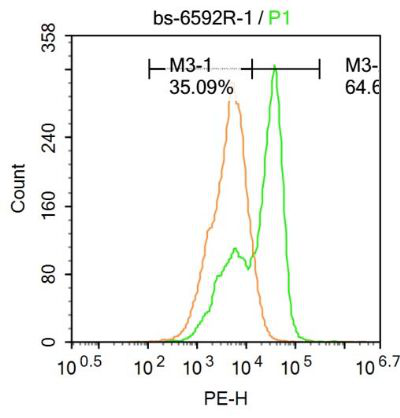产品货号 : mlR6592
英文名称 : HSD17B6
中文名称 : 17-β-羟脱氢酶6抗体
别 名 : 17-beta-HSD 6; 17-beta-HSD6; 17-beta-hydroxysteroid dehydrogenase type 6; 3 hydroxysteroid epimerase; 3(alpha >beta) hydroxysteroid epimerase; 3(alpha >beta) hydroxysteroid epimerasel; 3-alpha->beta-HSE; 3-alpha->beta-hydroxysteroid epimerase; H17B6_HUMAN; HSD17B6; HSE; Hydroxysteroid (17 beta) dehydrogenase 6; Hydroxysteroid (17 beta) dehydrogenase 6 homolog (mouse); Hydroxysteroid 17 beta dehydrogenase 6; NAD+ dependent 3 alpha hydroxysteroid dehydrogenase 3 hydroxysteroid epimerase; NAD+ dependent 3 alpha hydroxysteroid dehydrogenase; Oxidative 3 alpha hydroxysteroid dehydrogenase; Oxidative 3-alpha hydroxysteroid dehydrogenase; Oxidoreductase; Retinol dehydrogenase; RODH; SDR9C6;Short chain dehydrogenase/reductase family 9C, member 6.
研究领域 : 信号转导 生长因子和激素
抗体来源 : Rabbit
克隆类型 : Polyclonal
交叉反应 : Human, Mouse, Rat, Pig, Horse,
产品应用 : WB=1:500-2000 ELISA=1:500-1000 IHC-P=1:400-800 IHC-F=1:400-800 Flow-Cyt=1ug/Test IF=1:100-500 (石蜡切片需做抗原修复)
not yet tested in other applications.
optimal dilutions/concentrations should be determined by the end user.
分 子 量 : 33kDa
细胞定位 : 细胞浆 细胞膜
性 状 : Lyophilized or Liquid
浓 度 : 1mg/ml
免 疫 原 : KLH conjugated synthetic peptide derived from human HSD17B6:61-160/317
亚 型 : IgG
纯化方法 : affinity purified by Protein A
储 存 液 : 0.01M TBS(pH7.4) with 1% BSA, 0.03% Proclin300 and 50% Glycerol.
保存条件 : Store at -20 °C for one year. Avoid repeated freeze/thaw cycles. The lyophilized antibody is stable at room temperature for at least one month and for greater than a year when kept at -20°C. When reconstituted in sterile pH 7.4 0.01M PBS or diluent of antibody the antibody is stable for at least two weeks at 2-4 °C.
PubMed : PubMed
产品介绍 : The protein encoded by this gene has both oxidoreductase and epimerase activities and is involved in androgen catabolism. The oxidoreductase activity can convert 3 alpha-adiol to dihydrotestosterone, while the epimerase activity can convert androsterone to epi-androsterone. Both reactions use NAD+ as the preferred cofactor. This gene is a member of the retinol dehydrogenase family. [provided by RefSeq, Aug 2013]
Function:
NAD-dependent oxidoreductase with broad substrate specificity that shows both oxidative and reductive activity (in vitro). Has 17-beta-hydroxysteroid dehydrogenase activity towards various steroids (in vitro). Converts 5-alpha-androstan-3-alpha,17-beta-diol to androsterone and estradiol to estrone (in vitro). Has 3-alpha-hydroxysteroid dehydrogenase activity towards androsterone (in vitro). Has retinol dehydrogenase activity towards all-trans-retinol (in vitro). Can convert androsterone to epi-androsterone. Androsterone is first oxidized to 5-alpha-androstane-3,17-dione and then reduced to epi-andosterone. Can act on both C-19 and C-21 3-alpha-hydroxysteroids.
Subcellular Location:
Microsome membrane; Peripheral membrane protein; Lumenal side. Early endosome membrane; Peripheral membrane protein; Lumenal side (Potential).
Tissue Specificity:
Detected in liver and prostate (at protein level). Detected in adult liver, lung, brain, placenta, prostate, adrenal gland, testis, mammary gland, spleen, spinal cord and uterus. Detected in caudate nucleus, and at lower levels in amygdala, corpus callosum, hippocampus, substantia nigra and thalamus. Detected in fetal lung, liver and brain.
Similarity:
Belongs to the short-chain dehydrogenases/reductases (SDR) family.
SWISS:
O14756
Gene ID:
8630
Important Note:
This product as supplied is intended for research use only, not for use in human, therapeutic or diagnostic applications.
产品图片












